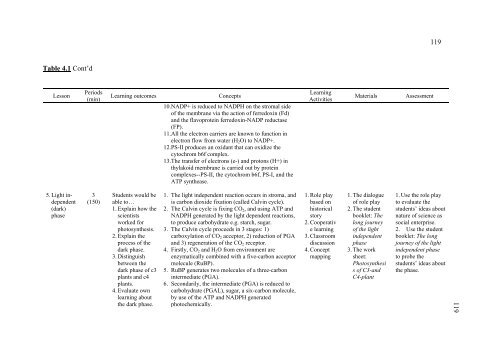an innovative approach
an innovative approach
an innovative approach
You also want an ePaper? Increase the reach of your titles
YUMPU automatically turns print PDFs into web optimized ePapers that Google loves.
Table 4.1 Cont’d<br />
Lesson<br />
5. Light independent<br />
(dark)<br />
phase<br />
Periods<br />
(min)<br />
3<br />
(150)<br />
Learning outcomes Concepts<br />
Students would be<br />
able to…<br />
1. Explain how the<br />
scientists<br />
worked for<br />
photosynthesis.<br />
2. Explain the<br />
process of the<br />
dark phase.<br />
3. Distinguish<br />
between the<br />
dark phase of c3<br />
pl<strong>an</strong>ts <strong>an</strong>d c4<br />
pl<strong>an</strong>ts.<br />
4. Evaluate own<br />
learning about<br />
the dark phase.<br />
10. NADP+ is reduced to NADPH on the stromal side<br />
of the membr<strong>an</strong>e via the action of ferredoxin (Fd)<br />
<strong>an</strong>d the flavoprotein ferredoxin-NADP reductase<br />
(FP).<br />
11. All the electron carriers are known to function in<br />
electron flow from water (H2O) to NADP+.<br />
12. PS-II produces <strong>an</strong> oxid<strong>an</strong>t that c<strong>an</strong> oxidize the<br />
cytochrom b6f complex.<br />
13. The tr<strong>an</strong>sfer of electrons (e-) <strong>an</strong>d protons (H+) in<br />
thylakoid membr<strong>an</strong>e is carried out by protein<br />
complexes--PS-II, the cytochrom b6f, PS-I, <strong>an</strong>d the<br />
ATP synthease.<br />
1. The light independent reaction occurs in stroma, <strong>an</strong>d<br />
is carbon dioxide fixation (called Calvin cycle).<br />
2. The Calvin cycle is fixing CO2, <strong>an</strong>d using ATP <strong>an</strong>d<br />
NADPH generated by the light dependent reactions,<br />
to produce carbohydrate e.g. starch, sugar.<br />
3. The Calvin cycle proceeds in 3 stages: 1)<br />
carboxylation of CO2 acceptor, 2) reduction of PGA<br />
<strong>an</strong>d 3) regeneration of the CO2 receptor.<br />
4. Firstly, CO2 <strong>an</strong>d H2O from environment are<br />
enzymatically combined with a five-carbon acceptor<br />
molecule (RuBP).<br />
5. RuBP generates two molecules of a three-carbon<br />
intermediate (PGA).<br />
6. Secondarily, the intermediate (PGA) is reduced to<br />
carbohydrate (PGAL), sugar, a six-carbon molecule,<br />
by use of the ATP <strong>an</strong>d NADPH generated<br />
photochemically.<br />
Learning<br />
Activities<br />
1. Role play<br />
based on<br />
historical<br />
story<br />
2. Cooperativ<br />
e learning<br />
3. Classroom<br />
discussion<br />
4. Concept<br />
mapping<br />
Materials Assessment<br />
1. The dialogue<br />
of role play<br />
2. The student<br />
booklet: The<br />
long journey<br />
of the light<br />
independent<br />
phase<br />
3. The work<br />
sheet:<br />
Photosynthesi<br />
s of C3-<strong>an</strong>d<br />
C4-pl<strong>an</strong>t<br />
119<br />
1. Use the role play<br />
to evaluate the<br />
students’ ideas about<br />
nature of science as<br />
social enterprise.<br />
2. Use the student<br />
booklet: The long<br />
journey of the light<br />
independent phase<br />
to probe the<br />
students’ ideas about<br />
the phase.<br />
119
















